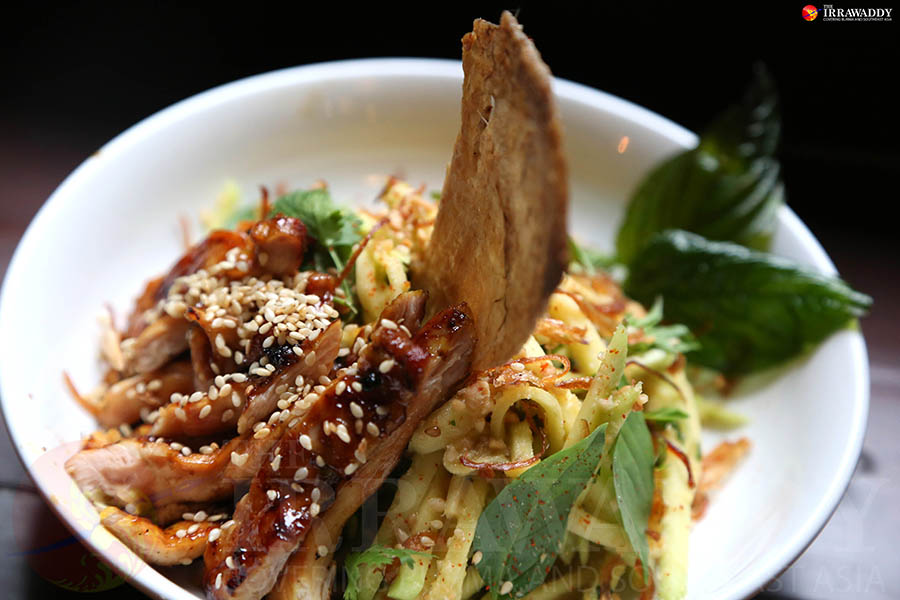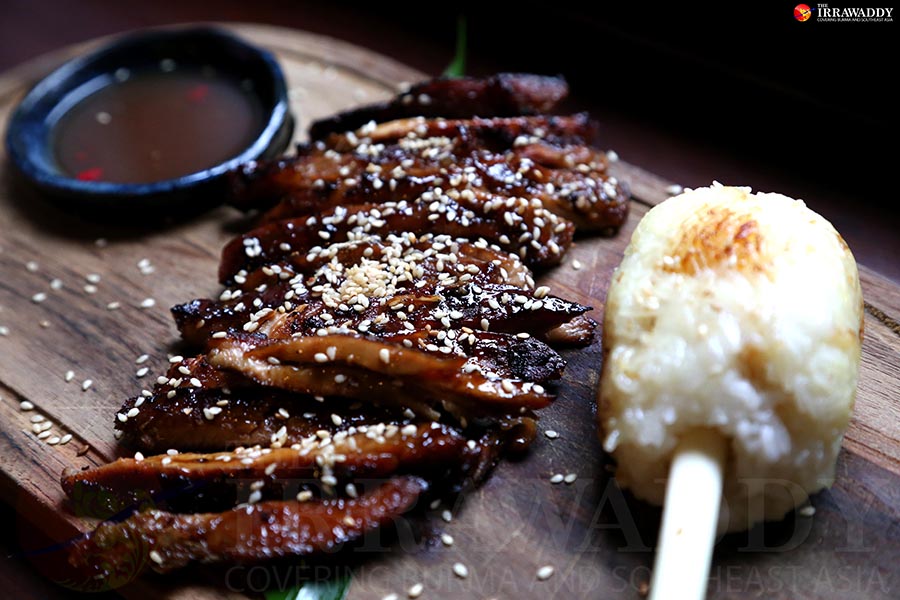YANGON — The transformation of a forgotten unit in the Lokanat Building from storage space to chic restaurant with colonial décor and Mekong-inspired fusion menu is the latest sign that Pansodan Street is having its renaissance as a downtown dining neighborhood.
Recently-opened Sofaer & Co., co-founded by restaurateur Ma Ingyin Zaw, serves up plates of Vietnamese, Thai, and Myanmar classics with a modern twist to diners perched on rattan and teak furniture surrounded by 100 year-old antique tiles, exposed brickwork and wooden paneling.
The restaurant’s menu includes modern takes on classics such as Tom Yum Gung and papaya salad with prices not unreasonable for its prime location. (It’s a more affordable option than Gekko, just around the corner.) It is the environment, however, that is likely to make the first (and perhaps lasting) impression.
“We like to think of the restaurant as a meeting place,” Ma Ingyin Zaw told The Irrawaddy. “It’s for people at a crossroads; people like you, people like me, people like Isaac Sofaer who built this amazing building.

Then known as the Sofaer Building, it became Yangon’s hottest commercial property in the 20th Century after it was constructed in 1906 and received the moniker of the Selfridges of Asia. Reuters Telegram Agency, the Bank of Burma, and Café Vienna all occupied units.
“We wanted the restaurant to feel like the building did in its heyday,” said Ma Ingyin Zaw. A painstaking renovation of a space that had been neglected for decades took six months to complete. Vintage features including exposed steel girders from Lanarkshire in Scotland, floor tiles, in green, gold, and dull red from Manchester in England and large wooden panels were scrubbed down and now shine.
The restaurant is largely double height with only a small private dining area on a mezzanine level at the back above the kitchen—it sits 15 for dinner or double that for drinks. With its own private bar, it’s going to prove popular for parties. The choice to keep the ceiling high will please heritage conservationists who derided KBZ bank for splitting the unit two doors down into two stories.

The wooden cladding along one side of the restaurant is Ma Ingyin Zaw’s favorite feature—she explained how they were found in a pile covered in a sheet at the back of the unit. She squealed with joy when it became clear all of the sections were still in the building.
The restaurant’s glassware was sourced from Yangon’s Nagar Glass Factory—a sprawling handmade glass factory tragically destroyed in Cyclone Nargis in 2008 but leaving a large number of pieces strewn around the jungle surrounds. Vintage marble and iron tables and handmade bamboo and rattan chairs complete a vintage aesthetic that Yangon Heritage Trust would be proud of. Unfortunately, cutlery and crockery sourced from Ikea somewhat hamper the vibe.
Sofaer & Co.’s Mekong menu is rooted in Yangon’s bountiful markets—some just a stone’s throw from the restaurant itself. Ma Ingyin Zaw expounds the virtues of a seasonal menu to make the most of the country’s finest products. Expect avocados from Taungyin in January, strawberries in February, and pineapples in September.

The Irrawaddy visited at peak mango season. Sofaer & Co.’s take on a traditional Burmese Thayat Thee Thoke (spicy green mango salad) uses slightly riper ma chitsu mangoes than the traditional recipe—Ma Ingyin Zaw and her team’s trick to add sweetness and cater to more tastebuds. It’s served with crispy chicken skin.
Another Myanmar dining staple Ohn-No Khao Swe (coconut chicken noodles) has been “innovated” to replace raw onion with cooked and served with grilled chicken. The Burman Scotch egg is one of the more outwardly fusion dishes—pork flavored with lemongrass and chili surrounds a local farm egg before being deep fried. It’s served with a homemade teriyaki sauce.
The grilled Mandalay tea leaf smoked pork neck is a highlight of the menu. The pork neck is smoked on fresh tea leaves before being lovingly grilled on the barbecue—the subtle tea leaf smokiness and the barbecue punch is a match made in heaven. It’s served with sticky rice on a lemongrass skewer—another Sofaer & Co. novelty.

The fusion continues with regionally flavored burgers—pulled pork curry with green mango and soft-shell crab with spicy som tam. There’s other regional staples including the mutton and tea leaf curry, bun cha (Vietnamese grilled pork paddies), and, of course, morning glory.
The cocktails are delicious—we tried the Sofaer Sour with gin, lime, egg white, and cinnamon bitters. There’s plenty of inviting cocktail promotions: the restaurant’s already hosted a gin and tonic week and are planning a whisky month. The Irrawaddy plans to hold Ma Ingyin Zaw to her promise of a soon to be introduced happy hour.
















